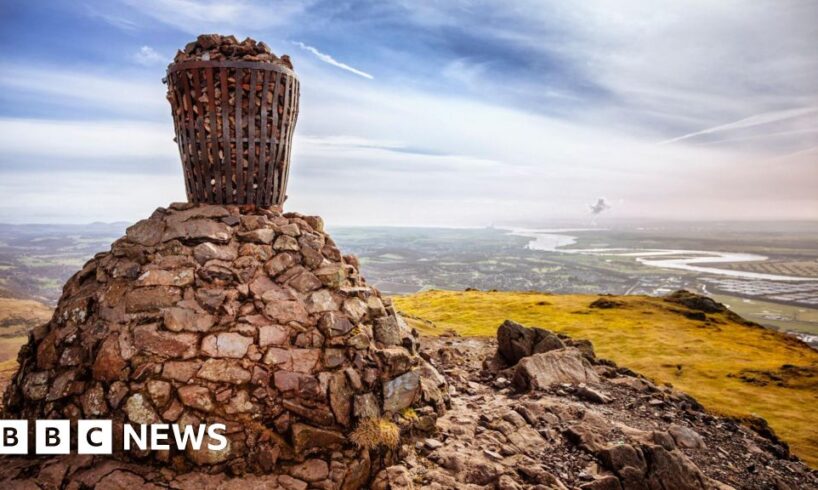
Getty Images
There are views of the Firth of Forth from the top of Dumyat in the Ochils
When a cherished loved one dies, relatives often decide to scatter their ashes at a significant landmark – a mountain, a cliff top, a riverbank.
But some hillwalkers are concerned that they are increasingly coming across piles of ashes during their treks in the countryside.
Beth Todd, 46, said she was “horrified” recently when she came across mounds of ashes at the top of Dumyat hill, near Stirling.
The John Muir Trust said it asks people not to scatter ashes on its land, which includes the summits of Ben Nevis at Fort William and Schiehallion in Perthshire, due to the detrimental impact it has on fragile habitats.
David Fleetwood, its director of land and policy, said they are often asked by relatives if ashes can be scattered on their land.
“There is the potential for alpine flora and soils to be adversely affected by the addition of ashes to a nutrient-poor environment,” he said.
“In addition, unexpectedly finding cremated ashes detracts from the enjoyment of others in a wild place and may be deeply upsetting.”
Ashes on summit
Mrs Todd said she realised she was surrounded by human ashes shortly after sitting on the ground and getting out her packed lunch at the summit of Dumyat.
“It was all around me and I was worried it might have blown into my sandwiches,” she said.
“It was all over the soles of our shoes and on my friend’s knee, it was disgusting and upset us all the way home,” the mother-of-two added.
A climber, who wishes to remain anonymous, told BBC Scotland News: “I see piles of ashes all the time.
“They scatter it at cliff tops at places where you are topping out when you are climbing,” he added.
This white shale-like substance at the top of Dumyat hill in Stirlingshire is understood to be cremated ashes
Dan Maltby, the chief operating officer of Future Forest Company, which owns Dumyat, said they understand why people choose to scatter ashes on their land.
“We understand that places like Dumyat hold deep personal meaning to people and why people choose Scotland’s hills to commemorate their loved ones,” he said.
“As custodians, we ask that it’s done with care for the environment and others who share it.
“We’d love to hear from people about how we can create thoughtful, living ways to remember those who’ve passed in the landscapes we steward.”
westend61/Getty Images
The John Muir Trust said they often received requests to scatter ashes on their land including the summits of Ben Nevis
Mountaineering Scotland said many more hillwalkers and mountaineers were now requesting their ashes be scattered on the top of their favourite mountains.
“We would encourage people who wish to be remembered in this way to think about their chosen spot and try to avoid the summits of very popular mountain tops and consider alternative locations such as a corrie or a particular point on a ridge or on the lower slopes,” a spokeswoman told BBC Scotland News.
She said it also reduced the ecological impact on the surrounding area if ashes were buried instead of being scattered.
Fragile habitats
Human ashes are heavy and shale-like due to their bone content so often land in one spot rather than being blown away by the wind.
A Forestry and Land Scotland spokesperson said it was important to ensure ashes were not left in heaps on the ground.
“We understand that our forests and land mean a great deal to many people and that family and friends may want to scatter ashes in a special location they can visit whenever they choose,” they said.
“However, as some of the habitats we manage are particularly fragile, containing rare plants and wildlife, we respectfully ask that anyone looking to scatter ashes seek advice from the relevant regional office before doing so.
“If permission is granted to scatter ashes, we again respectfully ask that they are not left in a pile.
“This will ensure no one else comes into contact with the ashes and will minimise any impact on the soil.”
What does the law say about scattering ashes?
There are no UK-wide laws against scattering ashes, but permission from the landowner is required for public or private land, and environmental guidelines must be followed.
Landowner’s permission: You need permission from the landowner for scattering ashes on private land, including farmland and beaches. Ask permission from the local council if it is public land like a park. Your own land: You can scatter ashes on your own land.Environmental guidelines: Avoid scattering ashes within one kilometre (0.6 miles) of a drinking water supply and be mindful of sensitive areas like marinas, fishing spots, or nature reserves.Respect for others: Sepa suggests that when scattering ashes in a public place like a beach or park, consider other users and choose a quiet time of day , while Forestry and Land Scotland ask people not to leave piles of ashes.Local authorities: Check with your local authority for specific bylaws or guidelines in certain areas, such as national parks or coastal zones.
Source





